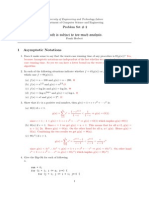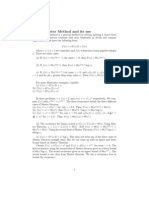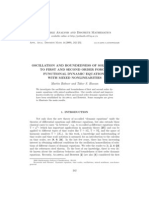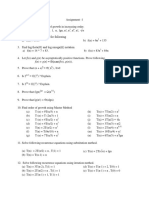0 ratings0% found this document useful (0 votes)
MT1
MT1
Uploaded by
Pawan_Singh_6974This document contains solutions to 25 problems applying the Master Theorem to determine the asymptotic runtime of recursive functions. The Master Theorem is used to solve recurrence relations of the form T(n) = aT(n/b) + f(n) by matching the problem to one of three cases. For each problem, the solution states either the asymptotic runtime using the Master Theorem case (such as Θ(n2) or Θ(n log n)) or that the Master Theorem does not apply.
Copyright:
Attribution Non-Commercial (BY-NC)
Available Formats
Download as PDF, TXT or read online from Scribd
Download as pdf or txt
MT1
MT1
Uploaded by
Pawan_Singh_69740 ratings0% found this document useful (0 votes)
This document contains solutions to 25 problems applying the Master Theorem to determine the asymptotic runtime of recursive functions. The Master Theorem is used to solve recurrence relations of the form T(n) = aT(n/b) + f(n) by matching the problem to one of three cases. For each problem, the solution states either the asymptotic runtime using the Master Theorem case (such as Θ(n2) or Θ(n log n)) or that the Master Theorem does not apply.
Copyright
© Attribution Non-Commercial (BY-NC)
Available Formats
PDF, TXT or read online from Scribd
Share this document
Did you find this document useful?
Is this content inappropriate?
This document contains solutions to 25 problems applying the Master Theorem to determine the asymptotic runtime of recursive functions. The Master Theorem is used to solve recurrence relations of the form T(n) = aT(n/b) + f(n) by matching the problem to one of three cases. For each problem, the solution states either the asymptotic runtime using the Master Theorem case (such as Θ(n2) or Θ(n log n)) or that the Master Theorem does not apply.
Copyright:
Attribution Non-Commercial (BY-NC)
Available Formats
Download as PDF, TXT or read online from Scribd
Download as pdf or txt
0 ratings0% found this document useful (0 votes)
MT1
MT1
Uploaded by
Pawan_Singh_6974This document contains solutions to 25 problems applying the Master Theorem to determine the asymptotic runtime of recursive functions. The Master Theorem is used to solve recurrence relations of the form T(n) = aT(n/b) + f(n) by matching the problem to one of three cases. For each problem, the solution states either the asymptotic runtime using the Master Theorem case (such as Θ(n2) or Θ(n log n)) or that the Master Theorem does not apply.
Copyright:
Attribution Non-Commercial (BY-NC)
Available Formats
Download as PDF, TXT or read online from Scribd
Download as pdf or txt
You are on page 1/ 3
Massachusetts Institute of Technology Handout 12
6.046J/18.410J: Introduction to Algorithms February 26, 2002
Professors Michel Goemans and Piotr Indyk
Master Theorem Worksheet Solutions
This is a worksheet to help you master solving recurrence relations using the Master Theorem.
For each recurrence, either give the asympotic solution using the Master Theorem (state
which case), or else state that the Master Theorem doesn’t apply. You should be able to go
through these 25 recurrences in 10 minutes.
Problem 1-1. T (n) = 3T (n/2) + n2
T (n) = Θ(n2 ) (case 3).
Problem 1-2. T (n) = 7T (n/2) + n2
T (n) = Θ(nlg 7 ) (case 1).
Problem 1-3. T (n) = 4T (n/2) + n2
T (n) = Θ(n2 lg n) (case 2).
Problem 1-4. T (n) = 3T (n/4) + n lg n
T (n) = Θ(n lg n) (case 3).
Problem 1-5. T (n) = 4T (n/2) + lg n
T (n) = Θ(n2 ) (case 1).
Problem 1-6. T (n) = T (n − 1) + n
M.T. doesn’t apply. Iteration gives T (n) = Θ(n2 ).
Problem 1-7. T (n) = 4T (n/2) + n2 lg n
T (n) = Θ(n2 lg2 n) (extended case 2).
Problem 1-8. T (n) = 5T (n/2) + n2 lg n
T (n) = Θ(nlg 5 ) (case 1).
2 Handout 12: Master Theorem Worksheet Solutions
Problem 1-9. T (n) = 3T (n/3) + n/ lg n
M.T. case 1 doesn’t apply since f (n) = n/ lg n is not polynomially smaller than nlog3 3−ε for
any ε > 0.
Problem 1-10. T (n) = 2T (n/4) + c
T (n) = Θ(n1/2 ) (case 1).
Problem 1-11. T (n) = T (n/4) + lg n
T (n) = Θ(lg2 n) (extended case 2).
Problem 1-12. T (n) = T (n/2) + T (n/4) + n2
M.T. doesn’t apply. Recursion tree gives guess T (n) = Θ(n2 ).
Problem 1-13. T (n) = 2T (n/4) + lg n
T (n) = Θ(n1/2 ) (case 1).
Problem 1-14. T (n) = 3T (n/3) + n lg n
T (n) = Θ(n lg2 n) (extended case 2).
√
Problem 1-15. T (n) = 8T ((n − n)/4) + n2 √
M.T. doesn’t apply. Using Akra-Bazzi can ignore n/4, which
√ gives Θ(n2 ). Could also use
2
M.T. to get an upper bound√of O(n ) by removing the n/4 term and a lower bound of
Ω(n2 ) by replacing the (n − n)/4 term by 0.24n.
√
Problem 1-16. T (n) = 2T (n/4) + n
T (n) = Θ(n1/2 lg n) (case 2).
Problem 1-17. T (n) = 2T (n/4) + n0.51
T (n) = Θ(n0.51 ) (case 3).
Problem 1-18. T (n) = 16T (n/4) + n!
T (n) = Θ(n!) (case 3).
Handout 12: Master Theorem Worksheet Solutions 3
Problem 1-19. T (n) = 3T (n/2) + n
T (n) = Θ(nlg 3 ) (case 1).
Problem 1-20. T (n) = 4T (n/2) + cn
T (n) = Θ(n2 ) (case 1).
Problem 1-21. T (n) = 3T (n/3) + n/2
T (n) = Θ(n lg n) (case 2).
Problem 1-22. T (n) = 4T (n/2) + n/ lg n
T (n) = Θ(n2 ) (case 1).
Problem 1-23. T (n) = 7T (n/3) + n2
T (n) = Θ(n2 ) (case 3).
Problem 1-24. T (n) = 8T (n/3) + 2n
T (n) = Θ(2n ) (case 3).
Problem 1-25. T (n) = 16T (n/4) + n
T (n) = Θ(n2 ) (case 1).
You might also like
- TRADITIONAL LIFE MOCK EXAM - 03102015 v.1 PDFNo ratings yetTRADITIONAL LIFE MOCK EXAM - 03102015 v.1 PDF8 pages
- Data Structures and Algorithms: (CS210/ESO207/ESO211)No ratings yetData Structures and Algorithms: (CS210/ESO207/ESO211)22 pages
- Unit I Introduction To Algoritm Design Session - 8No ratings yetUnit I Introduction To Algoritm Design Session - 87 pages
- Fundamental Algorithms, Assignment 4 SolutionsNo ratings yetFundamental Algorithms, Assignment 4 Solutions3 pages
- Truth Is Subject To Too Much Analysis .: Problem Set # 2No ratings yetTruth Is Subject To Too Much Analysis .: Problem Set # 24 pages
- IEOR 6711: Stochastic Models I Fall 2012, Professor Whitt SOLUTIONS To Homework Assignment 7No ratings yetIEOR 6711: Stochastic Models I Fall 2012, Professor Whitt SOLUTIONS To Homework Assignment 74 pages
- 13-Time Complexity For Recursive Algorithms-10!04!2023No ratings yet13-Time Complexity For Recursive Algorithms-10!04!20239 pages
- The Master Method and Its Use: Log A Ǫ Log ANo ratings yetThe Master Method and Its Use: Log A Ǫ Log A2 pages
- Algorithm Analysis and Design: Master TheoremNo ratings yetAlgorithm Analysis and Design: Master Theorem9 pages
- CS 161 Summer 2009 Homework #2 Sample Solutions: Problem 1 (24 Points)No ratings yetCS 161 Summer 2009 Homework #2 Sample Solutions: Problem 1 (24 Points)8 pages
- Lecture 4 - Solving Differential Equations Dy DT + P (T) y G (T)No ratings yetLecture 4 - Solving Differential Equations Dy DT + P (T) y G (T)5 pages
- CMSC 441: Homework #2 Solutions: Parag NamjoshiNo ratings yetCMSC 441: Homework #2 Solutions: Parag Namjoshi3 pages
- Advanced Algorithm Analysis: Muhammad Nadeem July 15, 2017No ratings yetAdvanced Algorithm Analysis: Muhammad Nadeem July 15, 201727 pages
- Data Structures and Algorithms (AT70.02)No ratings yetData Structures and Algorithms (AT70.02)8 pages
- Applicable Analysis and Discrete Mathematics: doi:10.2298/AADM0902242BNo ratings yetApplicable Analysis and Discrete Mathematics: doi:10.2298/AADM0902242B11 pages
- Boyce/Diprima 9 Ed, CH 2.1: Linear Equations Method of Integrating FactorsNo ratings yetBoyce/Diprima 9 Ed, CH 2.1: Linear Equations Method of Integrating Factors15 pages
- Parul University Piet/Pit-Cse Department SUBJECT: Design and Analysis of Algorithms (203105301) Assignment: 1No ratings yetParul University Piet/Pit-Cse Department SUBJECT: Design and Analysis of Algorithms (203105301) Assignment: 11 page
- Amortized Analysis Recurrence Relation (RR) : Backward Substitution For Solving RRNo ratings yetAmortized Analysis Recurrence Relation (RR) : Backward Substitution For Solving RR21 pages
- Differencial Equations Boyce Chapter 2 SolutionNo ratings yetDifferencial Equations Boyce Chapter 2 Solution52 pages
- 10+2 Level Mathematics For All Exams GMAT, GRE, CAT, SAT, ACT, IIT JEE, WBJEE, ISI, CMI, RMO, INMO, KVPY Etc.From Everand10+2 Level Mathematics For All Exams GMAT, GRE, CAT, SAT, ACT, IIT JEE, WBJEE, ISI, CMI, RMO, INMO, KVPY Etc.No ratings yet
- Logical progression of twelve double binary tables of physical-mathematical elements correlated with scientific-philosophical as well as metaphysical key concepts evidencing the dually four-dimensional basic structure of the universeFrom EverandLogical progression of twelve double binary tables of physical-mathematical elements correlated with scientific-philosophical as well as metaphysical key concepts evidencing the dually four-dimensional basic structure of the universeNo ratings yet
- Heapsort: By: Vimal Awasthi B.Tech (CSE)No ratings yetHeapsort: By: Vimal Awasthi B.Tech (CSE)27 pages
- Towers of Hanoi: Move N Disks From Pole A To Pole C Such That A Disk Is Never Put On A Smaller DiskNo ratings yetTowers of Hanoi: Move N Disks From Pole A To Pole C Such That A Disk Is Never Put On A Smaller Disk26 pages
- App Technology Lab: 8introduction To Data 8 8 8 8 8 8No ratings yetApp Technology Lab: 8introduction To Data 8 8 8 8 8 82 pages
- My Strengths Worksheet: Worksheet Strategy #4 - Life Skills: You, Your Job, Your CareerNo ratings yetMy Strengths Worksheet: Worksheet Strategy #4 - Life Skills: You, Your Job, Your Career5 pages
- Breakthrougher I (Surpass Your Aspirations)No ratings yetBreakthrougher I (Surpass Your Aspirations)150 pages
- SOB-Macro-V8 0_Operation_Manual_w01-en-ANo ratings yetSOB-Macro-V8 0_Operation_Manual_w01-en-A14 pages
- Tunku Abdul Rahman University of Management and TechnologyNo ratings yetTunku Abdul Rahman University of Management and Technology15 pages
- Trigonometry Solution JEE Main Archive DTS-1No ratings yetTrigonometry Solution JEE Main Archive DTS-12 pages
- Mv-Sales&logistics Statement 2024.03.01-2024.04.01No ratings yetMv-Sales&logistics Statement 2024.03.01-2024.04.0111 pages
- L320 Range Rover Sport - SPECS 5.0 V8 SuperCharged 2012 (AutoCAT) Especificaciones Specifications100% (1)L320 Range Rover Sport - SPECS 5.0 V8 SuperCharged 2012 (AutoCAT) Especificaciones Specifications12 pages
- 06-The Causes of The Breakdown and Its ConsequencesNo ratings yet06-The Causes of The Breakdown and Its Consequences22 pages
- CBT LEADERSHIP AND CHANGE MANAGEMENT - HR Elective IIINo ratings yetCBT LEADERSHIP AND CHANGE MANAGEMENT - HR Elective III9 pages
- Rama Viii Bridge of Thailand, Infrastructure-China State Construction Overseas Development Co.,LtdNo ratings yetRama Viii Bridge of Thailand, Infrastructure-China State Construction Overseas Development Co.,Ltd1 page
- Poly Aluminium Chloride Process Card 103 - 1/2100% (1)Poly Aluminium Chloride Process Card 103 - 1/22 pages
- Hire Purchase Answer For Tutorial QuestionsNo ratings yetHire Purchase Answer For Tutorial Questions2 pages
- A Step-By-step Look of Vegetable GrowingNo ratings yetA Step-By-step Look of Vegetable Growing2 pages
- Annex 3-1 Pro-Forma Proponent Compliance Monitoring Report (CMR) : Semi-Annual Module 5 of SMRNo ratings yetAnnex 3-1 Pro-Forma Proponent Compliance Monitoring Report (CMR) : Semi-Annual Module 5 of SMR5 pages






























































































